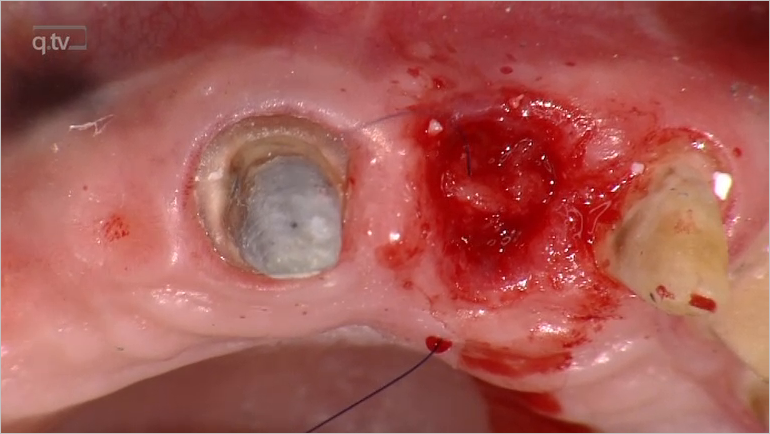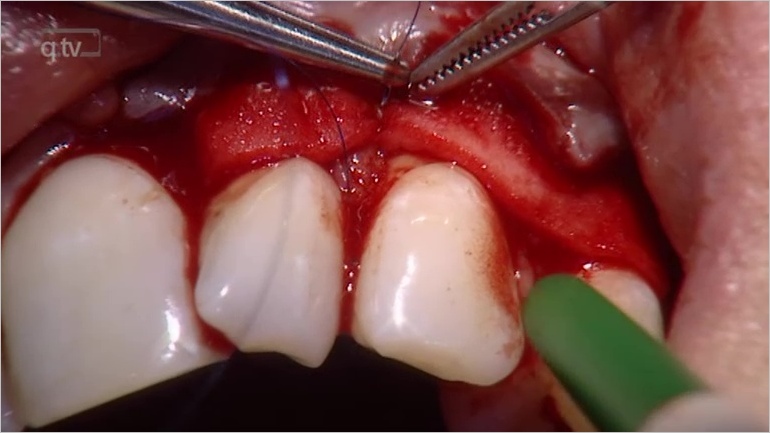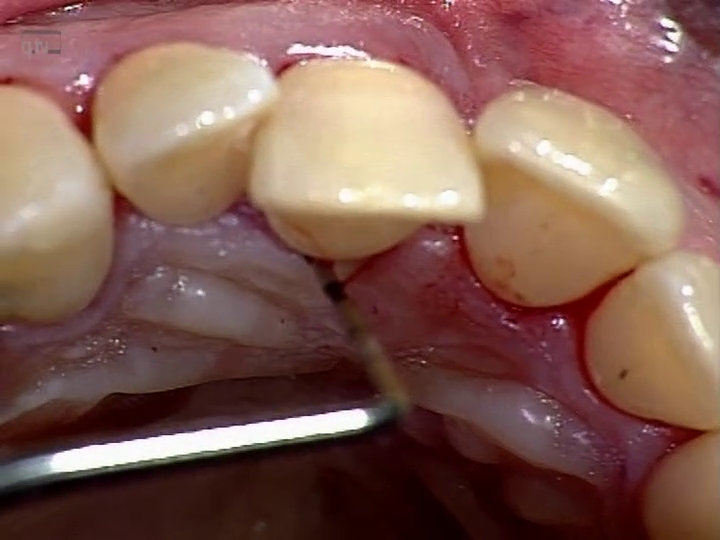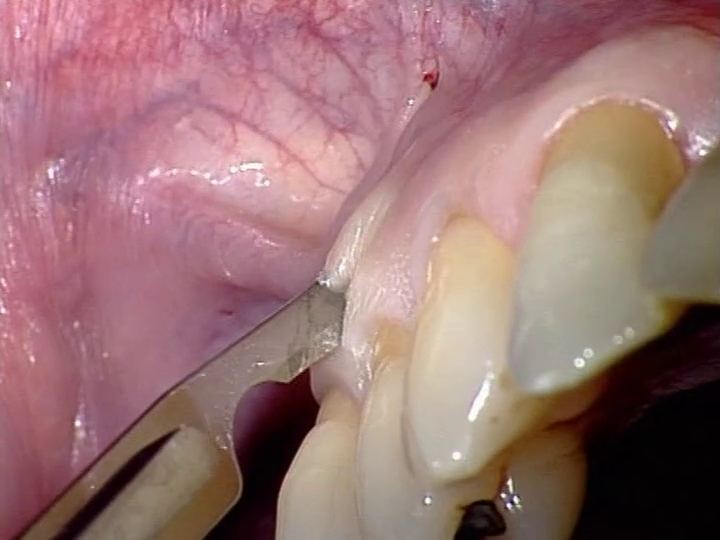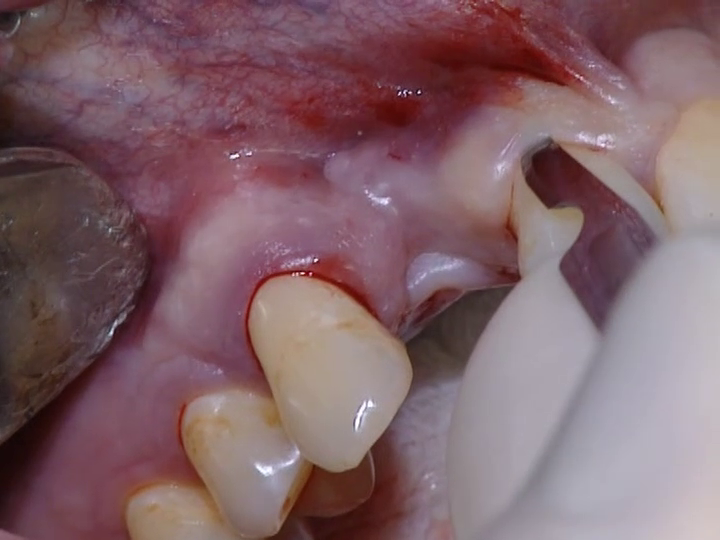Quintessence International, 1/2024
DOI: 10.3290/j.qi.b4479067, PubMed ID (PMID): 37800691Pages 28-40, Language: EnglishStumpf, Thomas / Rathe, Florian / Heumann, Christian / Sader, Robert / Schlee, MarkusObjectives: The consecutive case series accesses the results and experiences of ridge augmentation using an umbrella screw tenting technique.
Method and materials: In total, 279 patients were treated between 26 May 2015 and 16 June 2021, including horizontal and vertical ridge defects. Sex, age, smoking behavior, jaw, graft material, soft tissue thickness, extent of horizontal/vertical augmentation, resorption rate, and occurrence of early/late exposure were evaluated. Bone gain was determined by resorption at the screw head. Only cases without premature screw removal were evaluated metrically (n = 201). All other augmentations were evaluated according to whether implantation was possible with or without further augmentation (n = 27). A target performance index was calculated, which should enable evidence-based comparability of different augmentation methods in future.
Results: In total, 54 wound dehiscences (39 early, 15 late exposures) occurred, which corresponds to 24.08% of the augmented sites; 42 umbrella screws were removed prematurely. In all cases an implantation was possible at the desired position afterwards. Cases with a vertical augmentation component showed a higher prevalence of exposure (early, P = .000; late, P = .024). The extent of the vertical augmentation was only relevant for early exposure (P = .048). Mean bone gain of 4.23 ± 1.69 mm horizontally and 4.11 ± 1.99 mm vertically could be achieved. Regression analysis showed that there was no limit in horizontal/vertical direction. Mean percentage target performance index was 75.90 ± 20.54 for vertical and 82.25 ± 16.67 for horizontal portions.
Conclusion: The umbrella technique is an effective augmentation method, which can be applied to any defect morphology.
Keywords: horizontal ridge augmentation, implantation, ridge augmentation, target performance index, tenting technique, umbrella screws, umbrella technique, vertical ridge augmentation
The International Journal of Prosthodontics, 1/2024
DOI: 10.11607/ijp.8138, PubMed ID (PMID): 38381982Pages 16-26, Language: EnglishRathe, Florian / Junker, Rüdiger / Blumenröhr, Julia / Martin, Lukas / Löhlein, Niklas / Heumann, Christian / Auschill, Thorsten / Arweiler, Nicole / Schlee, MarkusPurpose: To examine the influence of abutment emergence angle and abutment height on marginal peri-implant bone stability in patients not considered susceptible to peri-implantitis. Furthermore, it was analyzed whether titanium-base (Ti-base) abutments lead to wider abutment emergence angles compared to one-piece abutments. Materials and Methods: A total of 48 abutments (ie, 24 Ti-base and 24 one-piece abutments in 24 patients) were evaluated at abutment installation, after 1 year, and thereafter on a yearly basis for up to 5 years. Clinical and radiographic outcome variables were assessed. Results: With regard to peri-implant marginal bone stability, only moderately negative, albeit significant, correlations were found on the mesial sides of the one-piece abutments after 4 and 5 years for an abutment emergence angle > 30 degrees. No statistically significant negative correlations were found for distances of ≤ 1.5 mm between the restoration margin and the crestal peri-implant bone level for either Ti-base or for one-piece abutments. Furthermore, abutments bonded to Ti-bases were not associated with larger emergence angles than one-piece abutments. Conclusions: For patients at low risk of developing peri-implantitis, it can be concluded that neither a larger abutment emergence angle (> 30 degrees) nor a distance of ≤ 1.5 mm between the restoration margin and the crestal peri-implant bone level are associated with marginal peri-implant bone loss. Furthermore, abutments bonded to Ti-bases are not associated with wider emergence angles than one-piece abutments.
Implantologie, 4/2022
Pages 403-416, Language: GermanRathe, Florian / Junker, Rüdiger / Heumann, Christian / Blumenröhr, Julia / Auschill, Thorsten / Arweiler, Nicole / Schlee, MarkusEine randomisierte kontrollierte 5-Jahres-StudieTitanbasen zur Verbindung mit CAD/CAM-gefertigten Abutments oder Kronen werden in der täglichen Praxis häufig verwendet. Aufgrund des engen Kontakts können sowohl die physikalischen als auch die chemischen Eigenschaften des Haftmaterials oder der Spalt selbst den Zustand des periimplantären Weichgewebes beeinflussen. Daher war es das Ziel der aktuellen klinischen Studie, die langfristigen Auswirkungen von individualisierten Abutments, die auf Titanbasen geklebt wurden, auf die periimplantäre Gesundheit zu untersuchen. An dieser prospektiven einfach verblindeten randomisierten kontrollierten klinischen Studie nahmen insgesamt 24 Patienten mit je einem Test- und einem Kontrollabutment teil. Dabei handelte es sich bei den Testabutments um CAD/CAM-gefertigte Titanabutments, die auf Titanbasen geklebt wurden. Als Kontrollabutments wurden individualisierte einteilige CAD/CAM-gefertigte Titanabutments verwendet. Bei der Installation der Abutments und danach jährlich bis zu 5 Jahren wurden die klinischen und röntgenologischen Parameter evaluiert. Signifikante Unterschiede des marginalen Knochenlevels (MBL) zwischen Titanbasen und einteiligen Abutments konnten zu keinem Nachuntersuchungszeitpunkt festgestellt werden. Wurde der MBL jedoch mit dem MBL zu Beginn der Behandlung verglichen, wurden bei mehreren Vergleichen signifikante Unterschiede festgestellt. Der Vergleich zwischen den Gruppen ergab für die Titanbasis-Abutments signifikant tiefere Taschen zu den Zeitpunkten der 4- (p = 0,006) und 5-Jahres-Nachbeobachtung (p = 0,024). Es scheint, dass die periimplantären Gewebe der spezifischen Patientenkohorte auf Titanbasis-Abutments im Vergleich zu einteiligen Abutments über einen längeren Zeitraum von 5 Jahren recht ähnlich reagieren. Aufgrund der geringen Aussagekraft der vorliegenden Studie können jedoch keine definitiven Schlussfolgerungen gezogen werden.
Manuskripteingang: 04.01.2022, Annahme: 18.02.2022
Keywords: Titanbasis, Titanabutment, Klebeabutment, Implantat, Klebebasis, periimplantärer Knochenverlust
Parodontologie, 4/2022
Pages 379-386, Language: GermanRathe, Florian / Schlee, MarkusFür eine erfolgreiche und nachhaltige Periimplantitistherapie scheinen folgende drei Punkte von ausschlaggebender Bedeutung zu sein: (1) vollständige Entfernung des Biofilms, (2) Rückgewinnung einer bioaktiven Oberfläche und (3) vollständige Reosseointegration bis zur Implantatschulter. Wie in der Artikelserie in dieser Ausgabe der PARODONTOLOGIE (s. Meyle et al. und Petsos et al.) ausgeführt, erfüllt die Verwendung des GalvoSurge-Gerätes (Fa. GalvoSurge, Widnau, Schweiz) für eine galvoelektrische Reinigung die ersten beiden Bedingungen für eine vollständige Reosseointegration der vormals kontaminierten Implantatoberfläche. Für eine vorhersagbare vollständige Reosseointegration bis zur Implantatschulter sind die Implantatposition und Defektanatomie als defektspezifische Faktoren von entscheidender Bedeutung. Patientenspezifische Faktoren wie z. B. Diabetes mellitus und Rauchen können wiederum günstige defektspezifische Faktoren negativ beeinflussen. Im Folgenden soll dem Leser ein klinisches Konzept anhand eines Entscheidungsbaumes für eine einfache klinische Implementierung an die Hand gegeben werden.
Manuskripteingang: 01.08.2022, Annahme: 25.10.2022
Keywords: Periimplantitis, Periimplantitistherapie, regenerative Periimplantitistherapie, galvoelektrische Reinigung, GalvoSurge
International Journal of Oral Implantology, 2/2022
PubMed ID (PMID): 35546725Pages 167-179, Language: EnglishRathe, Florian / Junker, Rüdiger / Heumann, Christian / Blumenröhr, Julia / Auschill, Thorsten / Arweiler, Nicole / Schlee, MarkusPurpose: Titanium bases are used frequently in daily practice for bonding to CAD/CAM abutments or crowns. Due to intimate contact between the adhesive gap of the titanium-base abutment and the peri-implant bone, the physical and chemical characteristics of the bonding material, or the gap itself, may affect peri-implant inflammatory reactions. The present study therefore aimed to examine the long-term effects of individualised abutments bonded to titanium bases on peri-implant health.
Materials and methods: A total of 24 patients, each with one test and one control abutment, participated in the present prospective, single-blind, randomised controlled clinical trial. The test abutments were CAD/CAM titanium abutments bonded to titanium bases. As the control abutments were individualised, one-piece CAD/CAM titanium abutments were used. Clinical and radiographic parameters were assessed at abutment insertion and then on a yearly basis over the following 5 years.
Results: No significant differences in marginal bone level were observed between the titanium-base and one-piece abutments at any of the follow-up time points; however, when intragroup marginal bone levels were compared to the baseline values, significant differences were found at several follow-up time points. Intergroup differences were only found to be significant for pocket depth at the 4- (P = 0.006) and 5-year follow-ups (P = 0.024), favouring titanium-base abutments.
Conclusions: Within the limitations of the present study, it appears that the peri-implant tissues of this specific patient cohort responded to titanium-base abutments in a rather similar manner to one-piece abutments over a 5-year period; however, no definitive conclusions can be drawn due to the low power of the present study.
Keywords: abutment, dental implant, peri-implant bone loss, titanium-base abutment
Conflict-of-interest statement: The authors declare there are no conflicts of interest relating to this study.
Implantologie, 2/2021
Pages 181-190, Language: GermanStumpf, Thomas / Rathe, Florian / Schlee, MarkusEin elektrolytisches Konzept zur PeriimplantitistherapieDie Prävalenz periimplantärer bakterieller Infektionen (Periimplantitis) wird von diversen Autoren mit 5, 10 oder 22 %, bezogen auf das Implantat, angegeben. Neben der medizinischen Problematik stellt dies eine volkswirtschaftliche Herausforderung dar. Über die Jahre wurden verschiedenste Ansätze zur Entfernung des bakteriellen Biofilms und damit der Behandlung der Periimplantitis vorgestellt. Mit keiner dieser Methoden gelang es, eine Oberfläche wiederherzustellen, die das Implantat vollständig reosseointegrieren ließ. In vielen Fällen erfolgte eine Rekolonisierung und -infektion der rauen Implantatoberfläche. Mit einem elektrolytischen Verfahren (GalvoSurge) gelang erstmals die vollständige Entfernung des bakteriellen Biofilms von allen getesteten Titanoberflächen. Durch Anlegen einer niedrigen elektrischen Spannung sowie die Umspülung mit einer elektrolytischen Reinigungslösung entstehen unter anderem Wasserstoffionen. Das positiv geladene Wasserstoffion durchdringt den bakteriellen Biofilm und wird an der Titanoberfläche reduziert. Die entstehenden gasförmigen Wasserstoffmoleküle heben den Biofilm ab, welcher mit der Reinigungslösung weggespült wird. Dieses Prinzip sowie die aktuelle wissenschaftliche Datenlage werden in dieser Fallserie diskutiert.
Manuskripteingang: 27.02.2021, Annahme: 29.04.2021
Keywords: GalvoSurge, Periimplantitis, elektrolytische Reinigung, Augmentation, Implantat
Implantologie, 4/2020
Pages 403-413, Language: GermanStumpf, Thomas / Rathe, Florian / Sader, Robert / Kraus, Bettina / Schlee, MarkusZur Augmentation atrophierter Kieferkämme wurden über die Jahre eine Vielzahl an Operationstechniken vorgestellt. Gemeinsames Ziel aller vorgestellten Methoden war es, ein ausreichendes Knochenvolumen für eine prothetisch orientierte Implantatposition zu generieren. Für keine dieser Methoden lag ausreiche Evidenz vor, einer anderen Technik überlegen zu sein. Die Umbrella-Technik zur Augmentation atrophierter Kieferkämme stellt eine einfache, an jede Defektmorphologie anpassbare Methode zur Stabilisierung des Augmentats dar. In der folgenden Fallserie wird die Anwendung der Technik anhand von 3 Fallbeispielen mit unterschiedlichen Defektgeometrien vorgestellt. Eine Dehiszenz während der Wundheilung lässt sich in der Regel einfach durch lokale desinfizierende Maßnahmen beherrschen. 234 Fälle wurden durch unsere Gruppe mittels Umbrella-Technik augmentiert. Im Zeitraum von Mai 2015 bis Januar 2020 ergaben sich im Mittel 4,72 mm an vertikalem (75 Fälle) und 4,29 mm (150 Fälle) an horizontalem Knochengewinn. In einigen Fällen konnten aufgrund frühzeitigen Schraubenverlusts keine Resorptionsdaten erhoben werden.
Manuskripteingang: 23.09.2020, Annahme: 21.10.2020
Keywords: Umbrella-Technik, Umbrellaschrauben, Augmentation, Implantat, Komplikation, Dehiszenz
Quintessence International, 4/2019
DOI: 10.3290/j.qi.a42160, PubMed ID (PMID): 30887961Pages 278-285, Language: EnglishKroiss, Sebastian / Rathe, Florian / Sader, Robert / Weigl, Paul / Schlee, MarkusObjectives: The present preference clinical trial compared the long-term outcome of acellular dermal matrix allograft (ADMA) versus autogenous connective tissue graft (CTG) in the treatment of gingival recessions.
Method and materials: Thirty-nine consecutive patients with 233 Miller Class I and II recessions were treated by one operator (MS) with coronally advanced flaps and in addition either ADMA or CTG harvested from their palate. Clinical parameters were measured by an independent and masked assessor at baseline, 6 months, and 5 years.
Results: Thirty-two patients could be recruited for long-term examination (seven dropouts). At 6 months and 5 years, all clinical parameters showed significant improvements in both groups with slightly better but statistically not significant clinical results for CTGs. At 5 years, the CTG group revealed an additional gain of keratinized mucosa width (t6m-0: CTG 1.88 mm, ADMA 1.04 mm, P = .081; and t5y-0: CTG 3.98 mm, ADMA 3.06 mm, P = .01) compared to 6 months, whereas the mean for ADMAs remained stable (intergroup comparison statistically significant, P = .010). In all other parameters in both groups, slight but not statistically significant relapses were detected. Only one minor postoperative complication at one ADMA-treated site occurred.
Conclusions: Regarding the long-term results, ADMA could be an alternative treatment option to thicken soft tissue and to cover multiple gingival recessions. If the gain of keratinized mucosa width is considered as a main goal, CTG may have a slight advantage over ADMA.
Keywords: acellular dermal matrix, connective tissue, gingival recession, long-term outcome, root coverage
Quintessenz Zahnmedizin, 5/2018
ParodontologiePages 512-519, Language: GermanRathe, Florian / Kühn, Sandrina Gabriele / Teutsch, Sandra / Schlee, MarkusGingivarezessionen können sowohl bei guter als auch bei schlechter Mundhygiene entstehen. Sie gehen häufig mit Überempfindlichkeiten der freiliegenden Wurzeln einher, begünstigen oftmals parodontale Entzündungen oder stellen für die Patienten ein ästhetisches Problem dar, was die drei Hauptindikationen für deren Behandlung sind. Die Rezessionsklassifikation nach Miller teilt die Defekte entsprechend ihrer Behandlungsprognose ein. So kann bei Rezessionen der Klassen I und II eine vollständige, bei Klasse-III- und -IV- Defekten hingegen nur eine unvollständige bzw. überhaupt keine Deckung erwartet werden. Der Beitrag geht im Speziellen auf die Tunneltechnik in Kombination mit dem freien subepithelialen Bindegewebstransplantat ein. Es werden nicht nur die verschiedenen Modifikationen dieser Technik abgehandelt, sondern auch die zu erwartenden Ergebnisse und Langzeitprognosen in Form einer eigenen Studie dargestellt.
Keywords: Weichgewebe, Gingivarezession, Rezession, Klassifikation, plastische Parodontalchirurgie, Tunneltechnik
International Journal of Esthetic Dentistry (EN), 2/2018
PubMed ID (PMID): 29687095Pages 146-170, Language: EnglishHinze, Marc / Janousch, Rainer / Goldhahn, Sabine / Schlee, MarkusObjective: To demonstrate in a prospective cohort study that immediate implantation and provisionalization in combination with the socket-shield technique will result in volume stability of the mucosa adherent to the inserted implant.
Material and methods: Patients with an indication for a single tooth implant underwent application of the socket-shield technique and immediate implantation of a provisional implant crown. A noninvasive volumetric measurement was performed according to the method described by Windisch et al (2007) at baseline and 12 weeks later. The influence of potential confounders was evaluated. Patients rated their satisfaction with the treatment, fitting accuracy of implant, intraoperative discomfort, postoperative pain, and ability to chew soft and hard foods using visual analog scales.
Results: Fifteen patients with a mean age of 49.2 ± 11.9 years were enrolled in the study. All implant sites showed uneventful healing and no socket-shield exposures were observed. The soft tissue volume change assessed with the mean distance change was 0.5 mm in all cases (-0.07 ± 0.16; range -0.37 to +0.32). A slight but significant influence of the buccal bone plate width on the soft tissue volume change was observed (b = 0.25; P = 0.037). No influence was found for apical bone height, width of gingival tissue, buccal recession or probing depths. The patients were highly satisfied with their treatment as well as with the pain and functional outcomes.
Conclusions: Based on preliminary data, preservation of a buccal root segment in conjunction with immediate implant placement and provisionalization can minimize buccal contour changes after tooth extraction on a short-term basis.




